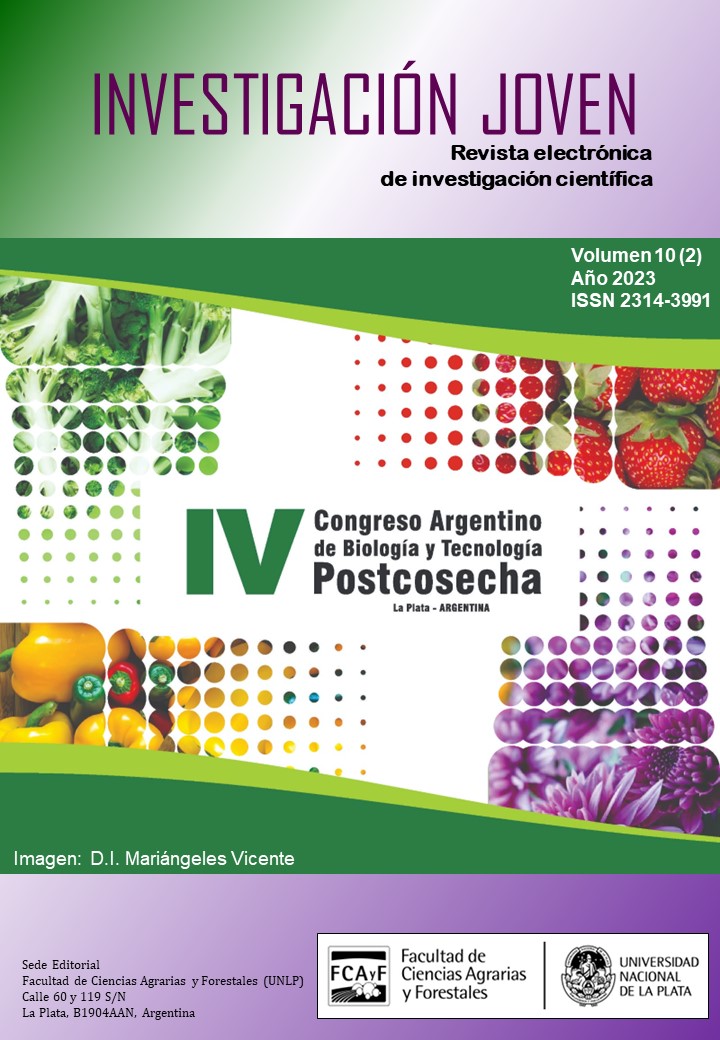Development of a porous material based on baru (Dipteryx alata Vog.) and its effect on the post-harvest storage of bananas
Palabras clave:
adsorption, activated carbon, ethylene, shelf life, climacteric fruitsResumen
Banana is a climacteric fruit marketed in tropical and subtropical regions with worldwide consumption demand. During its ripening process, several biochemical reactions occur linked to the production of ethylene (C2H4), which determine the useful life and quality of the fruit. Commercial activated carbons have been used as ethylene scavengers during storage and transportation of a wide variety of agricultural products. Thus, the objective of this study was to evaluate the effects of using an activated carbon synthesized from baru residues (Dipteryx alata Vog.) as a potentially efficient material in eliminating ethylene and maintaining the post-harvest quality of bananas. Activated carbon (ACB) was obtained by chemical activation using a phosphoric acid – H3PO4 solution (85%) followed by a carbonization step under nitrogen flow (160 cm3 min-1) for 40 min at 800°C. The specific surface area (SBET) and pore size distribution of ACB were measured by N2 adsorption at -196 °C. Dynamic adsorption of ethylene was conducted in a quartz fixed-bed flow adsorber loaded with 0.1 g of activated carbon sample. For the storage experiments, the bananas were separated into two groups, the first consisting of bananas stored without ethylene adsorbent material (control) and the second of bananas stored with 10g of ACB per container. The fruits were kept in glass desiccators for 12 days at 25°C and 75% relative humidity provided by a saturated sodium chloride
(NaCl) solution. Fruit quality parameters (weight loss, soluble solids content, total titratable acidity, pH and color) were evaluated on days 0 (initial), 4, 8 and 12 days. The results showed the development of a material with a well-developed surface area (492.41 m2 g-1), total pore volume of 0.28 cm3 g-1 and average pore size of 3.12 nm. These characteristics favored the adsorption of ethylene even at low concentrations, reaching a maximum adsorption capacity of 1111.1 ug/g according to the Langmuir model. The evaluation of quality attributes confirmed the effectiveness of ACB during the storage of bananas in the presence of ACB, resulting in a delay in the fruit ripening process. Bananas in contact with the adsorbent showed greater retention of green pigments and greater luminosity compared to bananas in the control group. In addition, this group had the lowest mass loss on the 12th day of storage, indicating better maintenance of freshness. The levels of soluble solids (attribute related to the sweet taste of the fruit) were higher in the samples from the control group, reaching 7.3% against 6% in the samples from the ACB group. Therefore, activated carbon proved to be a promising material to be used commercially as an ethylene adsorbent during the storage and transport of bananas and other agricultural commodities at a lower cost.
Descargas
Publicado
Número
Sección
Licencia
Derechos de autor 2023 T.F. Oliveira, A.C.J. Oliveira, E.T. Marsico, H. Valdés

Esta obra está bajo una licencia internacional Creative Commons Atribución-NoComercial-CompartirIgual 4.0.


















